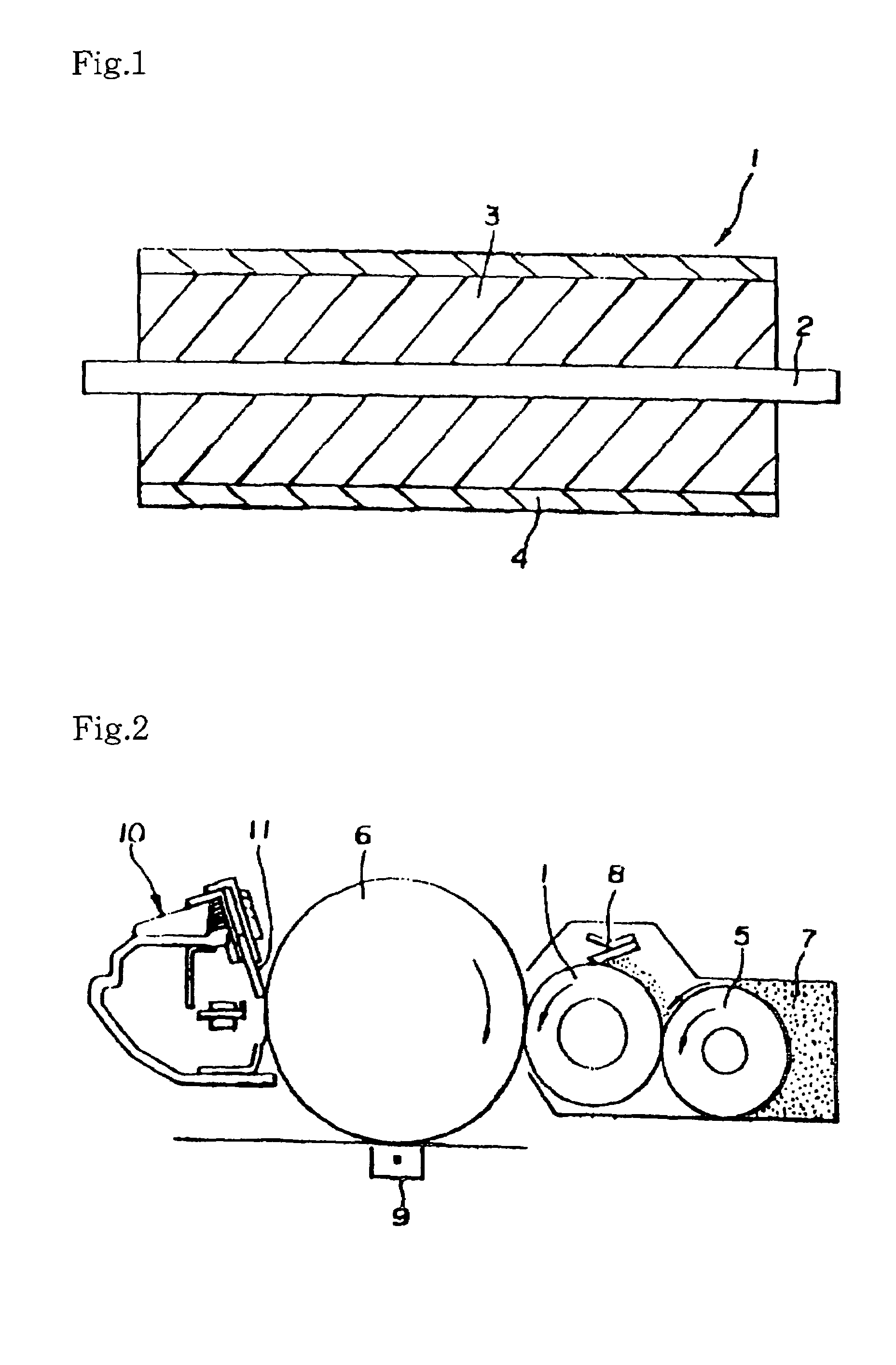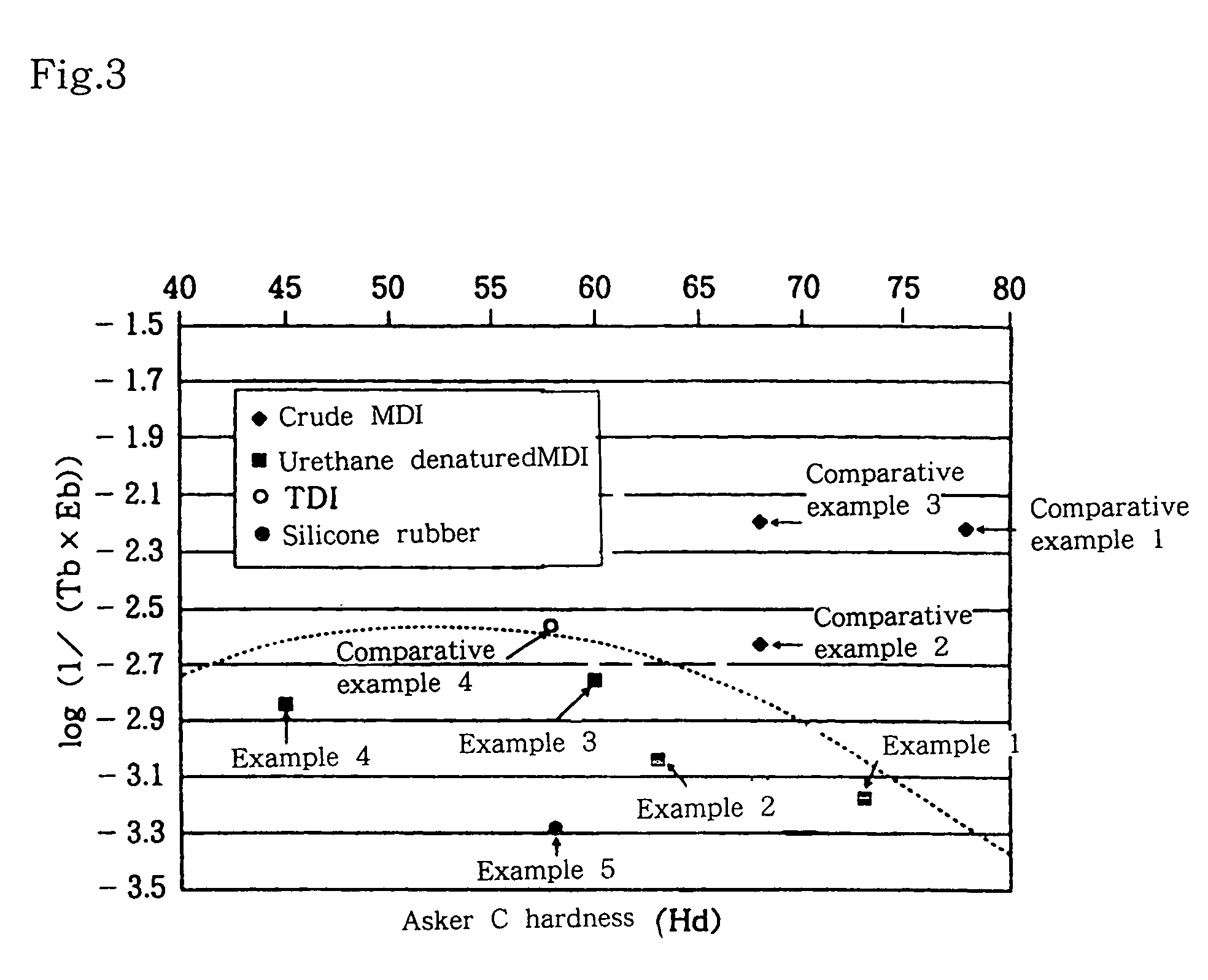Elastic roller
a technology of elastic rollers and rollers, applied in the direction of electrographic processes, instruments, corona discharge, etc., can solve the problems of insufficient durability of rollers, and achieve the effect of free of deterioration in abrasion resistan
- Summary
- Abstract
- Description
- Claims
- Application Information
AI Technical Summary
Benefits of technology
Problems solved by technology
Method used
Image
Examples
examples
[0065]The present invention will now be described in further detail hereinafter by way of examples which are intended to be only illustrative and therefore not restrictive.
Preparation of Elastic Materials
example 5
[0067]The elastic material as a silicone elastomer was obtained as follows. A proper amount of 2,5-dimethyl-2,5-di(tert-butylperoxy)-hexane as a cross-linking agent was added to the silicone material designated by H in Table. 1 below. The mixture was kneaded and pressure-cured for 10 minutes in a mold heated to 170° C. The material was then removed from the mold and was cured in an oven at 200° C. for 4 hours.
Preparation of Elastic Rollers
[0068]Each blend of the resin materials of examples 1 to 5 and comparative examples 1 to 4 was poured into a cylindrical mold having an inner diameter of 20 mm and having a stainless steel shaft with a diameter of 12 mm placed at the center thereof. The materials were allowed to cure at 100° C. for 1 hour and were removed from the molds. The molded materials were then finished to make elastic rollers by grinding on a cylindrical grinder. The finished roller had an elastic layer formed about the 12 mm shaft over a length of 230 mm and had an externa...
example 6
[0077]A polyol composition was prepared by blending 2.85 parts by weight of acetylene black into 100 parts by weight of polyisoprene polyol (OH value: 47.1) having a molecular weight of 2500, and mixing the mixture using a mixer. The polyol composition was stirred under reduced pressure to remove bubbles contained therein. 13.33 parts by weight of crude MDI (crude m-xylylene diisocyanate) (NCO weight %: 31.7) were added to the composition and the mixture was stirred for 2 minutes. 0.001 parts by weight of dibutyl tin dilaurate were then added to the mixture and the mixture was further stirred for 3 minutes. The mixture was then poured into a mold in which a metal shaft was preliminarily placed and which was preheated to 90° C. A roller was obtained by allowing the composition to harden at 90° C. for 12 hours to form a conductive elastic layer on the surface of the metal shaft. The surface of resulting roller was abraded to have an average surface roughness of 8 μmRz in accordance wi...
PUM
| Property | Measurement | Unit |
|---|---|---|
| tensile strength Tb | aaaaa | aaaaa |
| tension fracture elongation Eb | aaaaa | aaaaa |
| RH | aaaaa | aaaaa |
Abstract
Description
Claims
Application Information
 Login to View More
Login to View More - R&D
- Intellectual Property
- Life Sciences
- Materials
- Tech Scout
- Unparalleled Data Quality
- Higher Quality Content
- 60% Fewer Hallucinations
Browse by: Latest US Patents, China's latest patents, Technical Efficacy Thesaurus, Application Domain, Technology Topic, Popular Technical Reports.
© 2025 PatSnap. All rights reserved.Legal|Privacy policy|Modern Slavery Act Transparency Statement|Sitemap|About US| Contact US: help@patsnap.com


